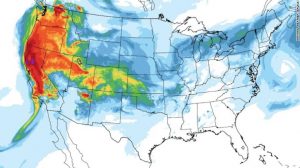Sep
18

Posted by Catherine Martin on September 18th, 2018
Posted in: All of Us, Public Health
Tags: Citizen Science, Health Literacy

August 10, 2018 CNN satellite photo of California wild fire
Health Literacy is not a new topic for Americans. As a nation we have been adjusting to the latest developments on how to keep ourselves healthy for decades. Whether that be following the national Food Pyramid to the updated “healthy plate” or changing our perspective of how we prevent illness as we age. We follow an upbeat track to health – well we intend to do that. Sometimes we just aren’t ready or prepared. When attending the Centers for Disease Control and Prevention conference in Atlanta this past week I’ve discovered campaigns that try to innovate ways to communicate the “get and stay healthy” message.
Several sessions caught my attention and I’d like to share them. First, I attended a Pre-Conference on Health Literacy as a Driver of Healthier Communities. This session provided links to the National Action Plan to Improve Health Literacy @ http://www.health.gov/communication/HLActionPlan. We reviewed the Needs Assessment with an ‘honest’ approach to who will participate versus who we really want to participate when we are looking into changing community health behaviors. One large component of this assessment is that we are all trying to organize the same action plan and with the right resources/tools we can get the job done. Examples used were the National Assessment of Adult Literacy which has state and county estimates and can be found at: http://nces.ed.gov/naal/estimates/StateEstimates.aspx; and Health Literacy Universal Precautions Toolkit at http://www.ahrq.gov/qual/literacy/. These resources can help with program planning.
Another message I’d like to share with you from this conference was from the “Challenging Traditional Methods of Public Health Messaging” session. One speaker reminded us to look to the behavioral change not by generalized demographics but to look within each group by segment. For example, teens should not be grouped by age but by the things that are meaningful to them. In this case, it was music. The teens were branded as popular, country, alternative, hip-hop and a moderate/traditional group. Within the traditional group they were less likely to use tobacco or be part of unhealthy behaviors. This group was about 30% of all teens. The second group falls into popular and are more apt to follow others, perhaps for attention and they were more likely to smoke and drink in high school. The other teen groups, alternative (Goth was mentioned), country or hip-hop had positive behavior changes in reducing or removing negative health habits (smoking, drinking) from their lifestyle when advertisements were paired with their group’s popular musicians tell their audiences that they don’t smoke or drink. Studies showed that this messaging works!
The last two messages that had an environmental direction in health was regarding a Citizen Science study called Smoke Sense. This is a downloadable app from the Environmental Protection Agency (www.epa.gov/air-research/smoke-sense) that provides information about air quality, wild land fires, and smoke from those fires across the U.S. This mobile application provides a way for users to learn how smoke affects their health, allows them to anonymously log health symptoms and smoke observations, and promotes preventive healthy behaviors around wild land fire smoke exposure.
The final segment is all about ticks, yes, those nasty little virus hoarding parasites that apparently are almost as dangerous as the world’s most deadly creature, the mosquito. Unbeknownst to me, ticks are prolific all year around. Dr. Mather, aka the Tick Doctor, had a great presentation regarding tick identification, removal of these little pests and how you could be a “tick spotter” https://tickencounter.org/tickspotters as a Citizen Science project for your school or public library. One neat fact I learned is that not all ticks are inactive in the fall and winter. Another reason to learn more about my environment. Happy sleuthing!